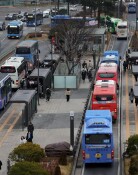Working Conditions Could Trigger Miscarriage
Working Conditions Could Trigger Miscarriage
Posted April. 11, 2008 03:06,
About half of the working women who have suffered spontaneous abortions picked mental stress as a main cause, calling for an urgent need to change working patterns and improve working conditions.
▽ Standing for a long time
The Planned Population Federation of Korea and the Healthcare Research Center at Hanyang University conducted in January a survey of 2,437 women in seven regions, including Seoul, Gangwon, Gwangju, Jeju, Ulsan, North Gyeongsang and South Jeolla, on the experience of spontaneous abortions.
Of 506 women who have had spontaneous abortions, 49.21 percent, or 249 respondents, said it was because of mental stress, while house chores and environmental factors were thought to have caused the miscarriage by 12.06 percent and 6.92 percent, respectively.
Contrary to artificial abortions, where fetuses are forcibly removed by, for instance, a cesarean section, spontaneous abortions refer to the natural termination of pregnancy.
According to the survey, among those who have suffered miscarriages, 44 percent worked for more than 40 hours a week and 21 percent of them were at work for less than 40 hours a week.
By working style, those who worked standing for a long period of time suffered the most (25.5 percent), followed by those who did the work involving vibration (7.5 percent), lifting heavy stuff (3.6 percent), and squatting (3 percent).
At the time of the miscarriage, 32.6 percent were working in normal working hours, 16.4 percent were working on a 12-hour shift, and 10.28 percent were working on an irregular basis. Working at night and on other special cases made up the remaining 28.26 percent, the survey found.
▽ The most risky period
The average number of pregnancy of the respondents was 2.5 times and that of miscarriage was 0.3. By age, 32.25 percent were those aged between 25 and 34, 33.11 percent were aged 35 to 44, and more than 65 percent were in their mid-20s to mid-30s. Meanwhile, those aged 24 and younger and those aged between 45 and 54 suffered the least by 9.07 percent and 15.59 percent, respectively.
According to the survey, the period most vulnerable to miscarriages was 7.2 weeks after pregnancy. Under the current labor law, those women who suffer abortions after the 16th week of pregnancy and stillbirth are entitled to a special maternal leave. The gap indicates that the revision of the law is necessary.
The survey showed that working women want governmental support such as paid leave (27.8 percent) or a safe working environment (24.1 percent) when they expecting babies.
In addressing low birth rates, making a safe environment for pregnant women is no less important than encouraging women to have babies. To reduce miscarriage rates, we should make a more favorable working environment for pregnant women. Those who work standing should be allowed to sit on chairs or given other types of work, said Lee Eun-hwa, who is in charge of promoting health for women in the child-bearing age at the Planned Population Federation of Korea.
zozo@donga.com







